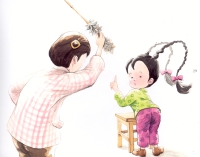| ________________
CM . . .
. Volume XIV Number 2 . . . . September 14, 2007
excerpt:
Based on the author’s own childhood experiences in China, this attractive picture book tells an entertaining tale about a young Chinese girl who is exuberant and curious about the world around her. Undeterred by adults’ disapproval about the way that she acts because it is not how girls should act, the protagonist Wen asks questions about why things are the way they are and does things like climbing trees. Even though her curiosity and attempts to help have unintended effects, she remains the same as ever. The story, itself, is not structured around a well-defined plot but rather is an episodic narrative of incidents that aim to flesh out Wen’s character and the social environment in which she grows up. Wen grows up among well-meaning adults who would want Wen to act like a “quiet, clean, and well-behaved” girl so that she will maintain her family’s good reputation and find a good husband when she grows up. However, Wen struggles against the adults’ rigid expectations, particularly as her naturally inquisitive behaviour goes against their views about how children should behave. Although it is firmly rooted in Chinese culture, this story transcends cultural boundaries. It will serve well as a historical example that is accessible to young children who will identify with Wen and her desire to express her own identity. Readers will identify with Wen’s incessant questioning of the environment around her and sympathize with her when things go wrong. Although Wen’s mother does disapprove of Wen’s behaviour sometimes, she is also depicted by Wang as a sympathetic person who does recognize and accept Wen’s differences from other Chinese girls.
Illustrated by Wei Xu, an award-winning artist, the book’s illustrations help to convey an appropriate tone for Wang’s story. The simply drawn, coloured illustrations are not overly realistic and strive for a more animated, cartoon-like appearance instead, which is appropriate because of the book’s more lighthearted topic. They connote the protagonist Wen’s exuberance and emotions, particularly through their depiction of her facial expressions, body language, and pigtails in active and spontaneous poses. The close-ups of Wen’s face encourage reader identification with her when she is sad as well as when she is happy or excited. The picture book’s language level makes it suitable for children ages 7 and up because it contains more difficult words such as “reputation,” courtyard,” and “embarrassment.” Though these words do not appear too frequently, younger children can better appreciate the story if parents and teachers read it aloud to them since there is also a fair amount of text on each page. Older children can better appreciate the book if they have some knowledge about the significance of Chinese sayings, which have historically been used to instruct children about how to live and behave, as well as the story’s historical and cultural context. As an instructional tool, this book will fit well into units about Chinese culture and children growing up in different cultures. Teachers could use the book to introduce students to Chinese proverbs and people’s perceptions of girls in traditional Chinese culture. It may be particularly interesting for students to examine the history behind the Chinese sayings and to compare them to English proverbs. This story’s humourous aspects will make the proverbs more accessible to children. One cautionary note about this book is that readers should avoid construing Wen’s actions as a rejection of Chinese culture per se. There are several stories now in which female characters feel constrained by their traditional culture’s gender expectations and rebel against them in order to assert their individuality. Although it is for younger children, Little Wen’s narrative trajectory is similar, and some readers may come away from this book with a negative impression of Chinese culture because of its gender constraints. Therefore, a sensitized understanding of traditional Chinese culture and its gender expectations will be beneficial. For more information about the author, readers can visit her website at http://www.ruowenwang.com/. Recommended. Huai-Yang Lim has recently completed a degree in Library and Information Studies at the University of Alberta.
To comment on this
title or this review, send mail to cm@umanitoba.ca.
Copyright © the Manitoba Library Association. Reproduction for personal
use is permitted only if this copyright notice is maintained. Any
other reproduction is prohibited without permission.
NEXT REVIEW |TABLE OF CONTENTS FOR THIS ISSUE
- September 14, 2007. AUTHORS
| TITLES | MEDIA REVIEWS
| PROFILES
| BACK ISSUES
| SEARCH | CMARCHIVE
| HOME |

